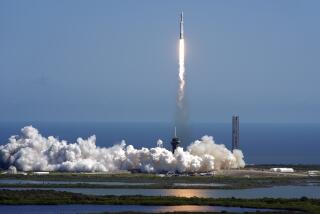Water geysers erupt on Europa! Could Jupiter’s icy moon host life?
Jupiter’s icy moon Europa squirts water like a squishy bath toy when it’s squeezed by the gas giant’s gravity, scientists say. Using NASA’s Hubble Space Telescope, they caught two 124-mile-tall geysers of water vapor spewing out over seven hours from near its south pole.
The discovery, described in the journal Science and at the American Geophysical Union meeting in San Francisco, shows that Europa is still geophysically active – and that this world in our own solar system could hold an environment friendly to life.
“It’s exciting,” said Lorenz Roth, a planetary scientist at the Southwest Research Institute in San Antonio and one of the study’s lead authors. “The results are actually more convincing than I would have thought before.”
Europa isn’t the only squirty moon in our planetary system: Saturn’s moon Enceladus has also been caught shooting water out of its south pole in so-called tiger stripes. These pretty plumes are caused by tidal forces. Just as our moon’s gravity squeezes and stretches the Earth a bit, causing the oceans to rise and fall, Saturn’s massive gravitational pull squeezes and stretches its tiny moon, causing cracks on its icy surface to open and allowing water to shoot out.
Scientists have long wondered whether something similar was happening on Jupiter’s moon Europa. After all, its surface is about 65 million years old, which is extremely young by our solar system’s standards, little more than 1.5% of the solar system’s age. This should mean that some geophysical processes must be constantly renewing the surface.
But over several decades, researchers repeatedly failed to catch the moon in action, said Robert Pappalardo, a Jet Propulsion Laboratory planetary scientist who was not involved in the study.
When the Voyager spacecraft, launched in 1977, flew by Europa, it caught a tiny blip on the moon’s edge that people thought might be a plume, but it could not be confirmed. Then the 1989 Galileo spacecraft saw a potential plume of its own. But this turned out to be digital residue, traces of a previous image, Pappalardo said.
Even Hubble probably wasn’t able to properly see such plumes until space shuttle astronauts on the very last servicing mission for the iconic space telescope in 2009 fixed one of its cameras. Even now, looking for water vapor in the ultraviolet wavelengths of light tests the limits of Hubble’s abilities, scientists said.
To catch Europa in the act, the researchers also knew they had to time their observations right. Saturn’s icy moon, Enceladus, shoots water near the farthest point in its orbit from Saturn, when the tidal forces cause cracks at the moon’s south pole to open. Around Jupiter, Europa was probably doing the same thing.
Sure enough, when the scientists looked at Europa when it was close to Jupiter in its orbit, they saw nothing. But in December 2012, when the ice moon was at its farthest point from the gas giant, they caught a pair of plumes bearing clear signs of oxygen and hydrogen – the components of water vapor – shooting from near the southern pole.
Scientists can’t say exactly where the plumes are coming from. It could be that they’re going directly from solid ice to gas, as Europa’s ice sheets rub against each other. But it could also be that the these plumes of vapor may be coming from the ocean of liquid water thought to lie under the moon’s frozen surface.
If the moon is still geophysically active, that could make it a prime environment for life.
Another study out of this week’s American Geophysical Union meeting found signs of clays on Europa’s surface. Clays are often associated with organic matter, which is why NASA’s Mars rover Curiosity is headed to Mt. Sharp, whose clay-rich layers could hold signs of life-friendly environments.
Those clays were probably brought to Europa by comets or asteroids, and if such material was able to make it into Europa’s subsurface ocean, it could provide the nutrient-rich soup that could allow life to emerge.
“We’re trying to understand, could this be a habitable environment today? Could there be life there today?” Pappalardo said. “At Europa, it seems the processes that could permit habitability may be going on now.”
Perhaps future studies can analyze all the contents of that watery plume and see if there are any signs of organic matter, Pappalardo said. Perhaps a future mission to Europa could fly through the plume and directly sample its contents.
For now, it’s important to replicate the results, he added.
“I will sleep better knowing that there are follow-up observations that confirm it,” Pappalardo said.
[For the Record, 3:53 p.m. PST Dec. 13: An earlier version of this post in one instance referred to Europa as a planet. It is a moon.]
ALSO:
Saturn’s icy moon Enceladus squirts water from ‘tiger stripes’
Harrowing: Italian astronaut describes nearly drowning in space
Mars and your sweaty armpits may have something in common
Eureka! NASA’s Curiosity rover finds ancient, life-friendly lake on Mars
Scary smart! Alligators and crocodiles use sticks to lure birds







